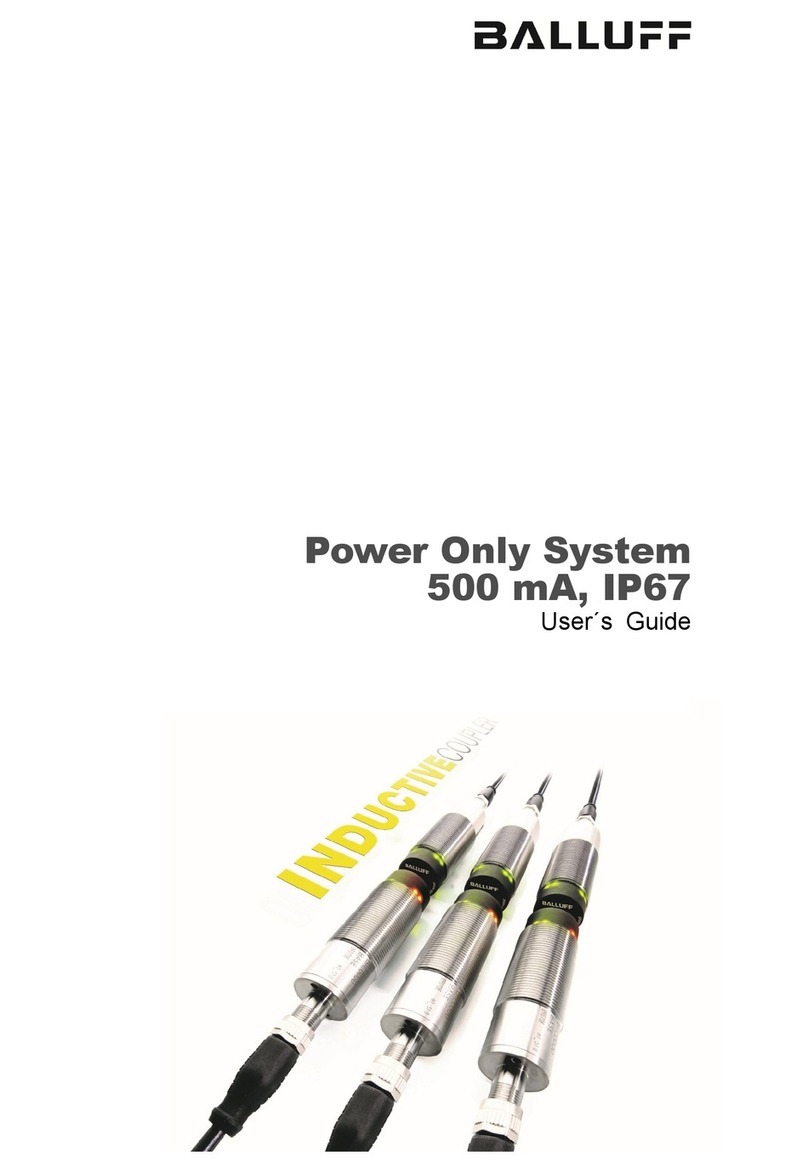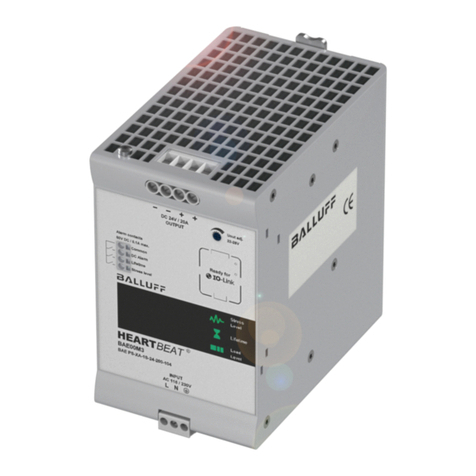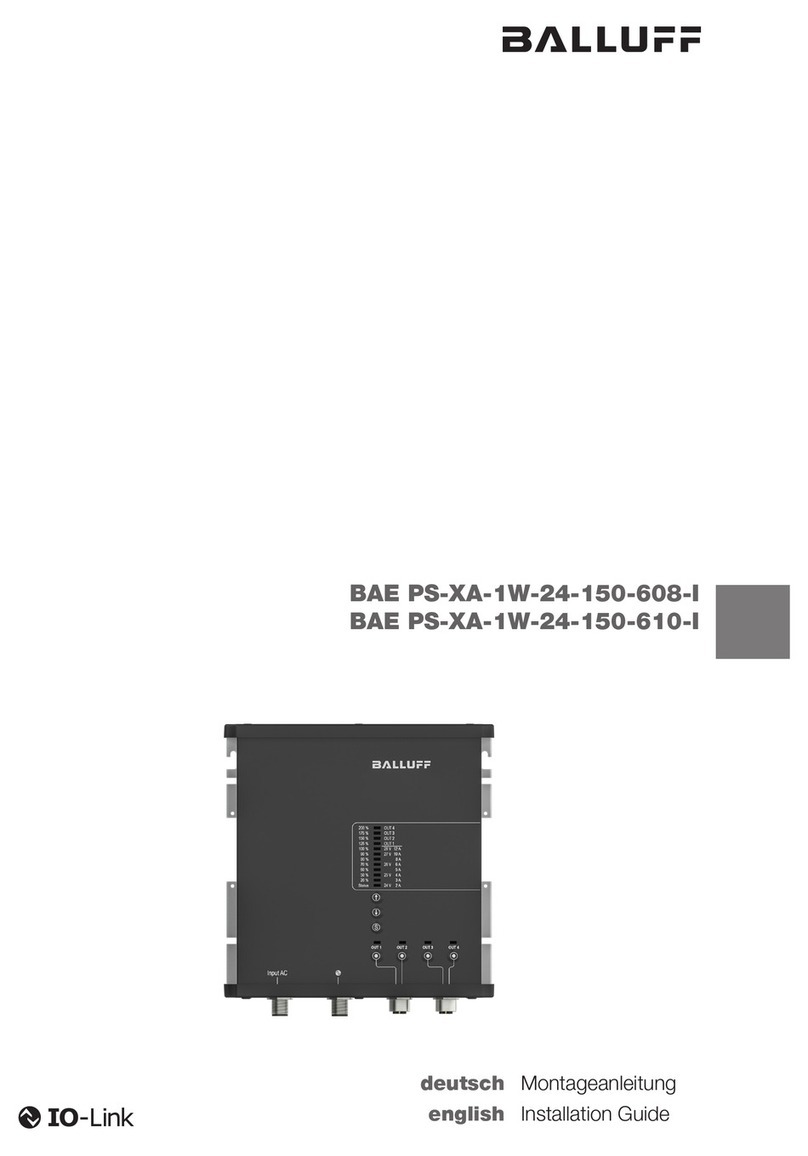
Diese Anleitung gilt für folgende Geräte:
BAE PS-XA-1W-12-085-54 (Bestellcode BAE00MC) Die gleiche Betriebsanleitung erhalten Sie auch im Internet unter
www.balluff.com.
Dieses Gerät ist ein primär getaktetes Schaltnetzgerät für die Ver-
wendung in Schalttafelinstallationen oder Einbauanwendungen, bei
denen der Zugang zum Netzgerät beschränkt ist (Berührungsschutz).
Das Gerät ist einsetzbar bei Verschmutzungsgrad 2.
Veränderungen am Gerät oder eine nicht bestimmungsgemäße
Verwendung sind nicht zulässig und führen zum Verlust von Gewähr-
leistungs- und Haftungsansprüchen gegenüber dem Hersteller.
Schaltnetzgeräte. BAE PS-XA-1W-12-085-054
Sicherheitshinweise
Gültigkeit Download der Betriebsanleitung
Bestimmungsgemäße Verwendung
Abmessungen
Installation
Installation
Vor Inbetriebnahme ist die Betriebsanleitung sorgfältig zu
lesen! Diese Geräte dürfen nicht in Anwendungen
eingesetzt werden, in denen die Sicherheit von Personen
von der Gerätefunktion abhängt (kein Sicherheitsbauteil
gem. EU-Maschinenrichtlinie).
Achtung!
Das Gerät gemäß den lokalen Vorschriften und Normen
ans Stromnetz anschließen. Das Gerät nicht abdecken!
Für die Kühlung ausreichend Raum um das Gerät
vorsehen, sonst kann sich das Gerät durch Überhitzung
abschalten. Die Lebensdauer des Geräts sinkt, sobald es
länger im überhitzten Zustand betrieben wird.
Das Gehäuse kann im Betrieb heiß werden!
Steckverbindungen nur bei ausgeschaltetem Strom
anschließen/trennen!
GEFAHR durch Hochspannung!
Die Berührung ungeschützter Leiter und Komponenten
kann zum Tod durch Stromschlag oder zu schweren
Verbrennungen führen.
Vor Arbeiten am Gerät die Stromversorgung unterbre-
chen und gegen Wiedereinschalten sichern. Keine
Gegenstände in das Gerät einführen. Von Feuer und
Wasser fernhalten.
GEFAHR durch elektrische Lichtbögen und tödlichen
Stromschlag!
Solange das Gerät in Betrieb ist, die Installation nicht
ändern! Dasselbe gilt für die Sekundärseite.
Die Installation und die Inbetriebnahme sind nur durch geschultes
Fachpersonal zulässig.
Der Betreiber hat die Verantwortung, dass die örtlich geltenden
Sicherheitsvorschriften eingehalten werden.
Insbesondere muss der Betreiber Maßnahmen ergreifen, dass bei
einem Defekt des Geräts keine Gefahren für Personen und Sachen
entstehen können.
Bei Defekten und nicht behebbaren Störungen des
Schaltnetzgeräts ist dieses außer Betrieb zu nehmen und gegen
unbefugte Benutzung zu sichern.
158
97
Ø3.5
Ø3.5
38
Bild 1: Abmessungen
Bild 2: Schaltnetzgerät befestigen. Position A
Montage
Für ausreichende Lüftung und Kühlung wird ein Raum von 25 mm
auf allen Seiten des Geräts empfohlen. Die Lüftungslöcher freihalten.
Falls mehrere Schaltnetzgeräte nebeneinander montiert werden,
genügend Abstand zwischen den Geräten einhalten, damit die
Lüftung gewährleistet wird.
1. Das Gerät gem. Bild 2 und 3 mit M3 Schrauben befestigen.
Beachten Sie: Die Schrauben dürfen eine Maximallänge nicht
überschreiten (4 mm bei Position A, 5 mm bei Position B).
Längere Schrauben können einen Kurzschluss verursachen.
2. Um Störungen zu vermeiden, die Eingangs- und die Ausgangs-
stromkabel getrennt voneinander verlegen.
Ausbau
1. Stromversorgung ausschalten und System vom Versorgungsnetz
trennen. Alle Steckverbinder vom Netzgerät trennen.
2. Die Schrauben lösen und das Gerät vorsichtig entfernen.
Montageposition A
Installation (Fortsetzung)
Anschlüsse
Technische Daten Technische Daten
Montageposition B
Bild 3: Schaltnetzgerät befestigen. Position B
Interne Sicherung
Die interne Eingangssicherung dient dem Schutz des Geräts und darf
vom Benutzer nicht ausgetauscht werden. Bei einem internen Fehler
ist das Gerät aus Sicherheitsgründen an den Hersteller zurückzuschi-
cken.
Elektrische Anschlüsse
−Daten für zulässige Lasten siehe Tabelle ”Technische Daten”.
−Ausschließlich kommerzielle Kabel verwenden, die für die
angegebenen Spannungs- und Stromwerte geeignet sind.
−Bei Flexkabeln sicherstellen, dass alle Litzen in der Klemme
gesichert sind (mögliche Gefahr eines Kurzschlusses).
−Korrekte Polarität am Ausgang sicherstellen.
−Bei Bedarf muss ein manuell steuerbares Trennelement zur
Trennung vom Versorgungsnetz verwendet werden.
−Geräte- und Stromkabel müssen korrekt abgesichert sein.
Erdung
Nicht ohne GND-Anschluss betreiben!
−Der ungesicherte Erdungsleiter muss an GND (Schutzklasse 1)
angeschlossen sein.
−Die Sekundärseite ist nicht geerdet. Bei Bedarf kann die Plus-
oder Minus-Klemme optional geerdet werden.
+
+
–
–
PE
N
L
V ADJ
OUT
Max. Anzugsdrehmoment für
Steckverbindung: 1,2 Nm
Bild 4: Anschlüsse
Einschaltzeit mit kapazitiver Last
Einschwingzeit mit kapazitiver Last
Schaltmodus parallel
Schaltmodus in Reihe
nicht möglich
max. 2 Geräte
88 V AC...264 V AC
120 V DC...375 V DC
Einschaltstrom
115 V AC
230 V AC
T3.15 A / 250 V AC, intern
Power Factor Correction (PFC)
gem. EN61000-3-2 Klasse D
Einstellbereich Ausgangsspannung
@0.8 lo
3% / °C von 46 °C bis +71 °C
Netzausfallüberbrückung (230 V AC)
25 mm auf allen Seiten des
Geräts
M3-Schrauben, max. Länge
4 mm bzw. 5 mm
relative Luftfeuchtigkeit
EN 61000-6-3, EN 61000-3-2,
EN 61000-3-3,EN 61000-6-2,
EN 61000-4-2, EN 61000-4-3,
EN 61000-4-4, EN 61000-4-5,
EN 61000-4-6, EN 61000-4-8,
EN 61000-4-11, EN 61204-3,
EN 55022 Class B
Balluff GmbH
Schurwaldstraße 9
73765 Neuhausen a.d.F.
Deutschland
Tel. +49 7158 173-0
Fax +49 7158 5010
balluff@balluff.de
Dok.-Nr./Doc. no. 916 459 DE/EN . I14; Änderungen vorbehalten/Subject to modification
5.50
117
23
3 x M3
L = max. 5 mm
150
19.30 28.80
28.50
10.80
18
Ø3.5
Ø3.5
23
5153
2 x M3
L = max. 4 mm
78
158
9.5065
97
84.50 7
























